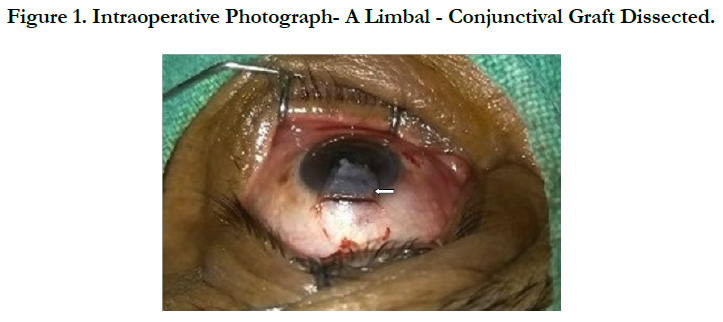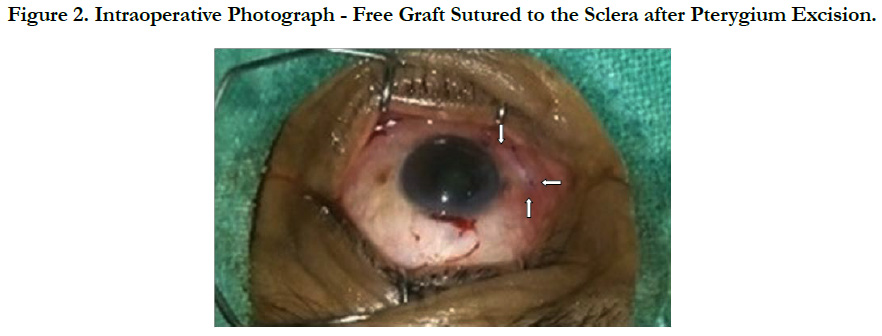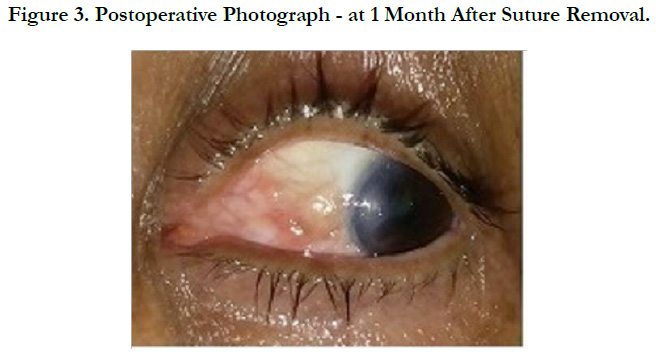Management of Recurrent Pterygium - A Case Report
Gupta A1*, Vardhan N1, Verma AK2
1 Resident, Ophthalmology Department, Dr. Radhakrishnan Government Medical College, Hamirpur, Himachal Pradesh, India.
2 Assistant Professor, Ophthalmology Department, Dr. Radhakrishnan Government Medical College, Hamirpur, Himachal Pradesh, India.
*Corresponding Author
Dr. Anushree Gupta, DNB,
Resident, Ophthalmology Department,
Dr. Radhakrishnan Government Medical College,
Hamirpur, Himachal Pradesh, India.
Tel: 7807498219
E-mail: anushree0612@gmail.com
Received: July 08, 2018; Accepted: August 10, 2018; Published: August 13, 2018
Citation: Gupta A, Vardhan N, Verma AK. Management of Recurrent Pterygium - A Case Report. Int J Ophthalmol Eye Res. 2018;6(5):384-386. doi: dx.doi.org/10.19070/2332-290X-1800077
Copyright: Gupta A© 2018. This is an open-access article distributed under the terms of the Creative Commons Attribution License, which permits unrestricted use, distribution and reproduction in any medium, provided the original author and source are credited.
Abstract
Pterygium is an uncontrolled fibrovascular overgrowth of the conjunctiva of the eye seen with a higher prevalence at areas near the equator. It has a high rate of recurrence which are usually more aggressive and difficult to treat. Several treatment modalities have been proposed, each having its own limitations. We report a case of recurrent pterygium which was treated with pterygium excision, intraoperative mitomycin c application and limbal conjunctiva graft taken from the same eye. No sign of recurrence was seen for follow up period of 1 year.
2.Abbreviations
3.Introduction
4.Case Report
5.Discussion
6.Conclusion
7.Declaration of Patient Consent
8.References
Keywords
Pterygium; Recurrent; Combined Treatment.
Abbreviations
5-FU: 5-Fluorouracil; MMC: Mitomycin C.
Introduction
Pterygium is a fibrovascular tissue overgrowth of the conjunctiva that overlays the sclera and involves the corneal surface. It is more prevalent in areas near the equator. The prevalence of pterygium has been reported to vary in different parts of the world with 2.83% in Australia [1], 9.84% in China [2] and 13% as reported in rural central India [3]. Susceptibility factors include environmentalinfluences such as ultraviolet exposure, dusty dry climate as well as genetic factors involving abnormalities in the DNA repair system [4]. They can reduce vision when involving visual axis, induce astigmatism and can also lead to diplopia and restricted ocular movements. Multiple surgical techniques have been developed. Bare sclera excision is a simple and oldest method but has a very high rate of recurrence (30%-80%) [5]. To overcome this limitation other procedures such as tissue grafting, such as with the conjunctival autograft (recurrence rate 0-15% ) [2], or amniotic membrane transplants, and use of adjuvants such as 5-fluorouracil (5-FU), mitomycin C (MMC), have been shown to be effective in preventing recurrences [6].
Most of the recurrences occur usually within first year [7]. A recurrence was defined as fibrovascular tissue crossing the corneoscleral limbus onto clear cornea in the area of previous pterygium excision. Recurrent pterygia after primary surgery are usually more aggressive and difficult to treat as it is accompanied by more conjunctival inflammation and scarring.
Case Report
A 40 year old female patient presented to our outpatient department at Dr. Radhakrishnan Government medical College in Himachal Pradesh, North India for eye evaluation. The best corrected visual acuity was 6/6 in right eye and 6/36 in left eye. She had a history of pterygium excision surgery 1 year back in the left eye. On examination, she had a recurrent pterygium in the left eye measuring 3 mm into the cornea.
Dilated fundus examination and intraocular pressure in both the eyes was within normal limits. Informed consent was obtained and the, the patient was scheduled for pterygium excision with limbal conjunctival graft along with intra operative mitomycin c (MMC). Surgery was performed under peribulbar anaesthesia. The pterygium head and body was dissected and excised. Subconjunctival pterygial tissue was excised and intraoperative MMC soaked sponges (0.02%) was applied to the bare sclera for 2 minutes. The site of application was then thoroughly irrigated with at least 100 ml of balanced salt solution. The area of bare sclera was measured after pterygium excision. A free conjunctival graft was harvested from the superior limbal region of dimensions approximately 1 mm larger than the recipient bed. The inferior margin of the graft was dissected 1mm towards the cornea to include part of the superficial limbus (Figure 1). The graft was transferred to the bare sclera epithelial side up while maintaining the limbal to limbal orientation. The four corners of the graft were then secured using 9-0 nylon suture (Figure 2). Postoperatively patient was put on eye drops Loteprednol 0.5% , lubricant and antibiotic eye ointment for 6 weeks. All sutures were removed 4 weeks after surgery (Figure 3). Mild graft edema was seen in the post operative period that later subsided with topical steroids. Her best-corrected visual acuity post surgery was 6/12 at 3 months. Corneal astigmatism was 1.75D before the surgery and 0.75 D after the surgery. Patient was followed up for 1 year and no recurrence was seen.
Discussion
Pathogenesis of pterygium formation is said to be multifactorial. A healthy limbus is said to act as a barrier to conjunctival overgrowth. Exposure to ultraviolet rays is said to play an important role by causing damage to limbal stem cells. The limbal corneal conjunctival epithelial barrier is disrupted and the cornea is actively conjunctivalized by tissue [8]. Recurrence has been proposed to occur due to aggressive wound healing seen in younger patients and absence of healthy conjunctival epithelium. Studies have shown that surgical technique for primary pterygium, use of adjuvants and morphological characteristics such as larger size and increased vascularity also determine recurrence [9]. Other mechanisms such as reproliferation of previously unexcised pterygial tissue, induced following an epithelial defect seen in bare sclera method or re growth of the remnant pterygial tissue have also been proposed [10, 11].
Treatment options for recurrent pterygium include pterygium excision with conjunctival autograft, conjunctivolimbal autograft or amniotic membrane with or without adjuvant such as mitomycin c [12]. The recurrence rates reported with these combined procedures are lower (0%-20%) than they are with a single procedure [13].
Recurrent pterygium surgery carries increased risk of intra and post-complications.
In our patient presenting with recurrent pterygium we did a combination procedure of conjunctival limbal graft along with intraoperative mitomycin c application to the graft bed after pterygium excision.We used low dose mitomycin c for 2 minutes only . This procedure has been done previously with favourable results [14, 15].
Complications like pannus formation, pseudopterygium at the donor site after limbal autografts have been reported. Mitomycin use has been linked to scleral thinning, corneal edema, secondary glaucoma, corneal perforation, persistent epithelial defects, endophthalmitis. Complications like graft oedema, chemosis and wound dehiscence can occur with conjunctival graft [16].
More recently, anti-VEGF treatment agents such as bevacizumab and ranibizumab are also been evaluated in primary and recurrent pterygium [17].
Conclusion
A combination of two procedures, conjunctival limbal autografting and adjunctive mitomycin c appears to be an effective and safe treatment for recurrent pterygium however more cases and longer follow up is required for definite conclusion.
Declaration of Patient Consent
The authors declare that they have obtained all appropriate patient consent forms. In the form the patients have give their consent for their images and other clinical information to be reported in the journal. The patients understand that their names and initials will not be published and due efforts will be made to conceal their identity, but anonymity cannot be guaranteed.
References
- Saw SM, Tan D. Pterygium: prevalence, demography and risk factors. Ophthalmic Epidemiol. 1999 Sep;6(3):219-28. PubMed PMID: 10487976.
- McCarty CA, Fu CL, Taylor HR. Epidemiology of pterygium in Victoria, Australia. Br J Ophthalmol. 2000 Mar;84(3):289-92. PubMed PMID: 10684840.
- Song P, Chang X, Wang M, An L. Variations of pterygium prevalence by age, gender and geographic characteristics in China: A systematic review and meta-analysis. PLoS One. 2017 Mar 29;12(3):e0174587. doi: 10.1371/journal.pone.0174587. PubMed PMID: 28355301.
- Nangia V, Jonas JB, Nair D, Saini N, Nangia P, Panda-Jonas S. Prevalence and associated factors for pterygium in rural agrarian central India. PLoS One. 2013 Dec 4;8(12):e82439. doi: 10.1371/journal.pone.0082439. PubMed PMID: 24324789.
- Jaros PA, DeLuise VP. Pingueculae and pterygia. Surv Ophthalmol. 1988 Jul-Aug;33(1):41-9. PubMed PMID: 3051468.
- Kaufman SC, Jacobs DS, Lee WB, Deng SX, Rosenblatt MI, Shtein RM. Options and adjuvants in surgery for pterygium: a report by the American Academy of Ophthalmology. Ophthalmol. 2013 Jan;120(1):201-8. doi: 10.1016/j.ophtha.2012.06.066. PubMed PMID: 23062647.
- Avisar R, Arnon A, Avisar E, Weinberger D. Primary pterygium recurrence time. Isr Med Assoc J. 2001 Nov;3(11):836-7. PubMed PMID: 11729580.
- Chui J, Di Girolamo N, Wakefield D, Coroneo MT. The pathogenesis of pterygium: current concepts and their therapeutic implications. Ocul Surf. 2008 Jan;6(1):24-43. PubMed PMID: 18264653.
- Ha SW, Park JH, Im Hee Shin HK. Clinical analysis of risk factors contributing to recurrence of pterygium after excision and graft surgery. Int J Ophthalmol. 2015 Jun 18;8(3):522-7. doi: 10.3980/j.issn.2222-3959.2015.03.15. PubMed PMID: 26086001.
- Kwon SH, Kim HK. Analysis of recurrence patterns following pterygium surgery with conjunctival autografts. Medicine (Baltimore). 2015 Jan;94(4):e518. doi: 10.1097/MD.0000000000000518. PubMed PMID: 25634207.
- Monden Y, Hotokezaka F, Yamakawa R. Recurrent pterygium treatment using mitomycin C, double amniotic membrane transplantation, and a large conjunctival flap. Int Med Case Rep J. 2018 Mar 7;11:47-52. doi: 10.2147/IMCRJ.S150969. PubMed PMID: 29563842.
- Aidenloo NS, Motarjemizadeh Q, Heidarpanah M. Risk factors for pterygium recurrence after limbal-conjunctival autografting: a retrospective, single- centre investigation. Jpn J Ophthalmol. 2018 May;62(3):349-356. doi: 10.1007/s10384-018-0582-9. PubMed PMID: 29549462.
- Mutlu FM, Sobaci G, Tatar T, Yildirim E. A comparative study of recurrent pterygium surgery: Limbal conjunctival autograft transplantation versus mitomycin C with conjunctival flap1. Ophthalmol. 1999 Apr;106(4):817-21. PubMed PMID: 10201608.
- Kheirkhah A, Hashemi H, Adelpour M, Nikdel M, Rajabi MB, Behrouz MJ. Randomized trial of pterygium surgery with mitomycin C application using conjunctival autograft versus conjunctival-limbal autograft. Ophthalmol. 2012 Feb;119(2):227-32. doi: 10.1016/j.ophtha.2011.08.002. PubMed PMID: 22153864.
- Katırcıoğlu YA, Altıparmak UE, Duman S. Comparison of three methods for the treatment of pterygium: amniotic membrane graft, conjunctival autograft and conjunctival autograft plus mitomycin C. Orbit. 2007 Mar;26(1):5-13. PubMed PMID: 17510864.
- Young AL, Leung GY, Wong AK, Cheng LL, Lam DS. A randomised trial comparing 0.02% mitomycin C and limbal conjunctival autograft after excision of primary pterygium. Br J Ophthalmol. 2004 Aug;88(8):995-7. PubMed PMID: 15258011.
- Zeng W, Liu Z, Dai H, Yan M, Luo H, Ke M, et al. Anti-fibrotic, anti- VEGF or radiotherapy treatments as adjuvants for pterygium excision: a systematic review and network meta-analysis. BMC Ophthalmol. 2017 Nov 25;17(1):211. doi: 10.1186/s12886-017-0601-5. PubMed PMID: 29178848.











